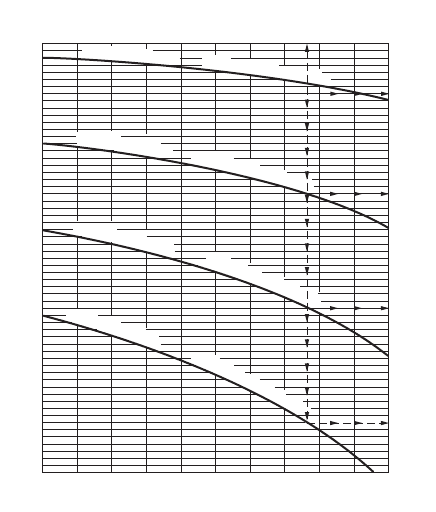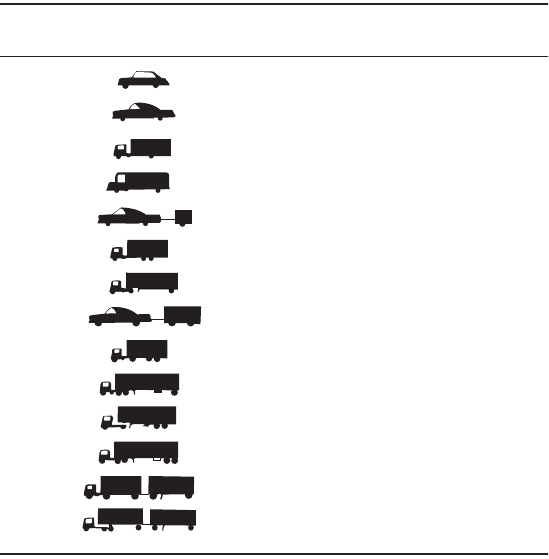Wai-Fah Chen.The Civil Engineering Handbook
Подождите немного. Документ загружается.

Urban Transit 61-33
Wilson, N. H., Nelson, D., Palmere, A., Grayson, T., and Cederquist, C. 1992. Service quality monitoring
for high-frequency transit lines. Transportation Research Record. 1349:1–11.
Zimmerman, S. L. 1989. UMTA and major investments: Evaluation process and results. Transportation
Research Record. 1209:32–36.
Further Information
Val uable comprehensive texts are:
Canadian Transit Handbook (3rd edition), Canadian Urban Transit Association, 1993.
Gray, G. E. and L. A. Hoel (eds.), Public Transportation (2nd edition), Prentice Hall, 1992.
Vuchic, V. R., Urban Public Transportation Systems and Technology, Prentice Hall, 1981.
For a more thorough treatment of transit management, its political environment, and terminology see
Altshuler, A., The Urban Transportation System: Politics and Policy Innovation, MIT Press, 1979.
Fielding, G. J., Managing Public Transportation Strategically: A Comprehensive Approach to Strengthening
Service and Monitoring Performance, Jossey-Bass, 1987.
Smerk, G. M., Mass Transit Management: A Handbook for Small Cities; Part 1: Goals, Support and Finance;
Part 2: Management and Control; Part 3: Operations; Part 4: Marketing (3rd ed., rev.), prepared by
Indiana University Institute for Urban Transportation for UMTA, Report no. DOT-T-88-12, 1988.
White, P. R., Public Transport, Its Planning, Management and Operation. London: Hutchinson, 1986.
Gray, B. H. (ed.), Urban Public Transportation Glossary, Tr ansportation Research Board, 1989.
More detail on advanced technology and software can be found in
Odoni, A. R., J. M. Rousseau, and N. H. Wilson, Models in urban and air transportation, in Handbook
on Operations Research and the Public Sector, Elsevier, 1994.
Paixao, J. and J. R. Daduna (eds.), Computer-Aided Transit Scheduling, Springer-Verlag, 1994.
Rousseau, J. M. (ed.), Computer Scheduling of Public Transport 2, Elsevier Science Publishers B.V., North-
Holland, 1985.
Wren, A. (ed.), Computer Scheduling of Public Transport Urban Passenger Vehicle and Crew Scheduling,
Elsevier Science Publishers B.V., North-Holland, 1981.
U.S. Department of Transportation, Advanced Public Transportation Systems: The State of the Art, Report
DOT-VNTSC-UMTA-91-2 and updated annually, U.S. Department of Transportation.
Many helpful conferences are held and reports published by the following organizations:
Federal Transit Administration, U.S. Department of Transportation
American Public Transportation Association
Canadian Urban Transit Association
Tr ansportation Research Board
© 2003 by CRC Press LLC

© 2003 by CRC Press LLC
62
Highway and Airport
Pavement Design
62.1 Introduction
62.2 Pavement Types and Materials
Flexible versus Rigid Pavement • Layered Structure of Flexible
Pavement • Rigid Pavement • Considerations for Highway and
Airport Pavements
62.3 Traffic-Loading Analysis for Highway Pavements
Tr affic Stream Composition • Traffic-Loading Computation •
Directional Split • Design Lane Traffic Loading • Formula for
Computing Total Design Loading
62.4 Traffic Loading Analysis for Airport Pavements
Tr affic Stream Composition • Computation of Traffic Loading •
Equal Stress ESWL • Equal Deflection ESWL • Critical Areas
for Pavement Design
62.5 Thickness Design of Flexible Pavements
AASHTO Design Procedure for Flexible Highway Pavements •
AI Design Procedure for Flexible Highway Pavements • FAA
Design Procedure for Flexible Airport Pavements • Mechanistic
Approach for Flexible Pavement Design
62.6 Structural Design of Rigid Pavements
AASHTO Thickness Design for Rigid Highway Pavements •
AASHTO Reinforcement Design for Rigid Highway Pavements •
PCA Thickness Design Procedure for Rigid Highway
Pavements • FAA Method for Rigid Airport Pavement Design
62.7 Pavement Overlay Design
AI Design Procedure for Flexible Overlay on Flexible Highway
Pavement • AI Design Procedure for Flexible Overlay on Rigid
Highway Pavement • PCA Design Procedure for Concrete
Overlay on Concrete Highway Pavement • FAA Design
Procedure for Flexible Overlay on Flexible Airport Pavement •
FAA Design Procedure for Flexible Overlay on Concrete
Airport Pavement • FAA Design Procedure for Concrete
Overlay on Concrete Airport Pavement
62.1 Introduction
Pavements are designed and constructed to provide durable all-weather traveling surfaces for safe and
speedy movement of people and goods with an acceptable level of comfort to users. These functional
requirements of pavements are achieved through careful considerations in the following aspects during
the design and construction phases: (a) selection of pavement type, (b) selection of materials to be used
for various pavement layers and treatment of subgrade soils, (c) structural thickness design for pavement
T. F. Fwa
National University of Singapore

62
-2
The Civil Engineering Handbook, Second Edition
layers, (d) subsurface drainage design for the pavement system, (e) surface drainage and geometric design,
and (f ) ridability of pavement surface.
The two major considerations in the structural design of highway and airport pavements are material
design and thickness design. Material design deals with the selection of suitable materials for various
pavement layers and mix design of bituminous materials (for flexible pavement) or portland cement
concrete (for rigid and interlocking block pavements). These topics are discussed in other chapters of
this handbook. This chapter presents the concepts and methods of pavement thickness design. As the
name implies,
thickness design
refers to the procedure of determining the required thickness for each
pavement layer to provide a structurally sound pavement structure with satisfactory performance for the
design traffic over the selected design life.
Drainage design
examines the entire pavement structure with
respect to its drainage requirements and incorporates facilities to satisfy those requirements.
62.2 Pavement Types and Materials
Flexible versus Rigid Pavement
Traditionally, pavements are classified into two categories, namely flexible and rigid pavements. The basis
for classification is the way by which traffic loads are transmitted to the subgrade soil through the
pavement structure.
As shown in Fig. 62.1, a
flexible pavement
provides sufficient thickness for load
distribution through a multilayer structure so that the stresses and strains in the subgrade soil layers are
within the required limits. It is expected that the strength of subgrade soil would have a direct bearing
on the total thickness of the flexible pavement. The layered pavement structure is designed to take
advantage of the decreasing magnitude of stresses with depth.
A
rigid pavement,
by virtue of its rigidity, is able to effect a slab action to spread the wheel load over
the entire slab area, as illustrated in Fig. 62.1. The structural capacity of the rigid pavement is largely
provided by the slab itself. For the common range of subgrade soil strength, the required rigidity for a
portland cement concrete slab (the most common form of rigid pavement construction) can be achieved
FIGURE 62.1
Flexible and rigid pavements.
(a) Typical Cross Section of Flexible Pavement
Wearing Course
Binder Course
Base Course
Subbase Course
Prepared Subgrade
Natural Subgrade
Tack Coat
Prime Coat
(b) Load Transmission in Flexible Pavement
Wheel
Load
(d) Load Transmission in Rigid Pavement
Wheel
Load
(c) Typical Cross Section of Rigid Pavement
Highway
Pavement
Airport
Pavement
Concrete Slab
Base or Subbase
Prepared Subgrade
Natural Subgrade
6-12 in
4-6 in
6-12 in
10-24 in
4-12 in
9-18 in
(1 in = 25.4 mm)
Highway
Pavement
Airport
Pavement
1-2 in
2-4 in
4-12 in
12-18 in
6-24 in
3-6 in
6-12 in
12-36 in
12-60 in
(1 in = 25.4 mm)

Highway and Airport Pavement Design
62
-3
without much variation in slab thickness. The effect of subgrade soil properties on the thickness of rigid
pavement is therefore much less important than in the case of flexible pavement.
Layered Structure of Flexible Pavement
Surface Course
In a typical conventional flexible pavement, known as
asphalt pavement,
the surface course usually
consists of two bituminous layers — a wearing course and a binder course. To provide a durable,
watertight, smooth-riding, and skid-resistant traveled surface, the wearing course is often constructed of
dense-graded hot mix asphalt with polish-resistant aggregate. The binder course generally has larger
aggregates and less asphalt. The composition of the bituminous mixtures and the nominal top size
aggregates for the two courses are determined by the intended use, desired surface texture (for the case
of wearing course), and layer thickness. A light application of tack coat of water-diluted asphalt emulsion
may be used to enhance bonding between the two courses. Table 62.1 shows selected mix compositions
listed in ASTM Standard Specification D3515 [1992]. Open-graded wearing courses, some with air void
exceeding 20%, have also been used to improve skid resistance and reduce splash during heavy rainfall
by acting as a surface drainage layer.
Base Course
Base and subbase layers of the flexible pavement make up a large proportion of the total pavement
thickness needed to distribute the stresses imposed by traffic loading. Usually base course also serves as
a drainage layer and provides protection against frost action. Crushed stone is the traditional material
used for base construction to form what is commonly known as the
macadam base course.
In this
construction, choking materials consisting of natural sand or the fine product resulting from crushing
coarse aggregates are added to produce a denser structure with higher shearing resistance. Such base
courses are called by different names, depending on the construction method adopted.
Dry-bound macadam is compacted by means of rolling and vibration that work the choking materials
into the voids of larger stones. For water-bound macadam, after spreading of the choking materials, water
is applied before the entire mass is rolled. Alternatively, a wet-mix macadam may be used by premixing
crushed stone or slag with a controlled amount of water. The material is spread by a paving machine
TA BLE 62.1
Example Composition of Dense Bituminous Paving Mixtures
Mix Designation and Nominal Maximum Size of Aggregate
Sieve Size
2 in.
(50 mm)
1
½
in.
(37.5 mm)
1 in.
(25.0 mm)
3/4 in.
(19.0 mm)
1/2 in.
(12.5 mm)
3/8 in.
(9.5 mm)
2
½
in. 100 — — — — —
2 in. 90–100 90–100 100 — — —
1
½
in. — 90–100 100 — — —
1 in. 60–80 — 90–100 100 — —
3/4 in. — 56–80 — 90–100 100 —
1/2 in. 35–65 — 56–80 — 90–100 100
3/8 in. — — — 56–80 — 90–100
No. 4 17–47 23–53 29–59 35–65 44–74 55–85
No. 8 10–36 15–41 19–45 23–49 28–58 32–67
No. 16 — — — — — —
No. 30 — — — — — —
No. 50 3–15 4–16 5–17 5–19 5–21 7–23
No. 100 — — — — — —
No. 200 0–5 0–6 1–7 2–8 2–10 2–10
Note:
Numbers in table refer to percent passing by weight.
Source:
ASTM, Standard Specification D3515-84,
Annual Book of ASTM Standards,
Vol. 04.03 —
Road and Paving Materials; Travelled Surface Characteristics, 1992. With permission.

62
-4
The Civil Engineering Handbook, Second Edition
and compacted by a vibrating roller. Table 62.2 shows specifications for unbound base and subbase
materials specified by AASHTO and ASTM.
Granular base materials may be treated with either asphalt or cement to enhance load distribution
capability. Bituminous binder can be introduced by spraying heated asphalt cement on consolidated and
rolled crushed stone layer to form a penetration macadam road base. Alternatively, bituminous road
bases can be designed and laid as in the case for bituminous surface courses. Cement-bound granular
base material is plant mixed with an optimal moisture content for compaction. It is laid by paver and
requires time for curing. Lean concrete base has also been used successfully under flexible pavements.
Table 62.3 shows examples of grading requirements for these materials.
TABLE 62.2(a)
Grading Requirements for Unbound Subbase and Base
Materials — ASSHTO Designation M147-65 (1989)
Grading: Percentage Passing
Sieve Size A B C D E F
50 mm 100 100
25 mm — 75–95 100 100 100 100
9.5 mm 30–60 40–75 50–85 60–100 — —
4.75 mm 25–55 30–60 35–65 50–85 55–100 70–100
2 mm 15–40 20–45 25–50 40–70 40–100 55–100
425
m
m 8–20 15–30 15–30 25–45 20–50 30–70
75
m
m 2–8 5–20 5–15 5–20 6–20 8–25
Other requirements:
1. Coarse aggregate (>2 mm) to have a percentage wear by Los Angeles
test not more than 50.
2. Fraction passing 425-
m
m sieve to have a liquid limit not greater than
25% and a plasticity index not greater than 6%.
Source:
AASHTO Designation M147-65,
AASHTO Standard Specifications
for Transportation Materials and Methods of Sampling and Testing,
American
Association of State Highway and Transportation Officials, Washington, D.C.,
1989. With permission.
TA BLE 62.2(b)
ASTM Designation
D2940-74 (Reapproved 1985)
Grading: Percentage Passing
Sieve Size Bases Subbases
50 mm 100 100
37.5 mm 95–100 90–100
19 mm 70–92 —
9.5 mm 50–70 —
4.75 mm 35–55 30–60
600
m
m 12–25 —
75
m
m 0–8 0–12
Other requirements:
1. Fraction passing the 75-
m
m sieve not to
exceed 60% of the fraction passing the
600-
m
m sieve.
2. Fraction passing the 425-
m
m sieve shall
have a liquid limit not greater than 25%
and a plasticity index not greater than 4%.
Source:
ASTM. 1992. ASTM Standard Specifi-
cation D2940-74 (reapproved 1980),
Annual Book
of ASTM Standards.
Vol. 04.03 — Road and Pav-
ing Materials; Travelled Surface Characteristics,
1992. With permission.

Highway and Airport Pavement Design
62
-5
Subbase Course
The subbase material is of lower quality than the base material in terms of strength, plasticity, and
gradation, but it is superior to the subgrade material in these properties. It may be compacted granular
material or stabilized soil, thus allowing building up of sufficient thickness for the pavement structure
at relatively low cost. On a weak subgrade, it also serves as a useful working platform for constructing
the base course. Examples of grading requirements for subbase materials are given in Table 62.2. The
TABLE 62.3
Requirements for Stabilized Base Courses
Specification
Cement Treated
Bituminous Treated
Lime TreatedClass A Class B Class C Class 1 Class 2
(a) Stabilized Base Courses for Flexible Pavements
Percent passing
2
½
in. 100 100 100
3/4 in. — — 75–95
No. 4 65–100 55–100 25–60
No. 10 20–45 — 15–45
No. 40 15–30 25–50 8–30
No. 200 5–12 5–20 2–15
7-day
f
c
(psi) 650–1000 300–650
S
(lb) — — — 750 min 500 min —
F
(0.01 in.) — — — 16 max 20 max —
PI 12 max — — 6 max 6 max 6 max
Specification
Type A
(Open
Graded)
Type B
(Dense
Graded)
Type C
(Cement
Graded)
Type D
(Lime
Treated)
Type E
(Bituminous
Treated)
Type F
(Granular)
(b) Base Materials for Concrete Pavement
Percent passing
1
½
in. 100 100 100 — — 100
3/4 in. 60–90 85–100 — * * —
No. 4 35–60 50–80 65–100 — — 65–100
No. 40 10–25 20–35 25–50 — — 25–50
No. 200 0–7 5–12 5–20 — — 0–15
(The minus No. 200 material should be held to a practical minimum)
28-day
f
c
(psi) — — 400–750 100 — —
S
(lb) — — — — 500 min —
F
(0.01 in.) — — — — 20 max —
Soil constants:
LL 25 max 25 max — — — 25 max
PI
*
N.P. 6 max 10 max — 6 max 6 max
Notes:
*
To be determined by complete laboratory analysis, taking into consideration the ability of the
stabilized mixture to resist underslab erosion.
f
c
=
compressive strength as determined in unconfined compression tests on cylinders 4 inches in
diameter and 4 inches high. Test specimens should contain the same percentage of portland
cement and be compacted to the same density as achieved in construction.
S
=Marshall stability.
F
=Marshall flow.
PI = plasticity index performed on samples prepared in accordance with AASHTO Designation
T-87 and applied to aggregate prior to mixing with the stabilizing admixture, except that, in
the case of lime-treated base, the value is applied after mixing.
LL= liquid limit.
Source:
AASHTO Interim Guide for Design of Pavement Structures,
American Association of State
Highway and Transportation Officials, Washington, D.C., 1972. With permission.

62
-6
The Civil Engineering Handbook, Second Edition
subbase course may be omitted if the subgrade soil satisfies the requirements specified for subbase
material.
Prepared Subgrade
Most natural soils forming the roadbed for pavement construction require some form of preparation or
treatment. The top layer of a specified depth is usually compacted to achieve a desired density. The depth
of compaction and the compacted density required depend on the type of soil and magnitudes of wheel
loads and tire pressures. For highway construction, compaction to 100% modified AASHTO density
covering a thickness of 12 in. (300 mm) below the formation level is commonly done. Compaction depth
of up to 24 in. (600 mm) may be required for heavily trafficked pavements. For example, in the case of
cohesive subgrade, the Asphalt Institute [1991] requires a minimum of 95% of AASHTO T180
(Method D) density for the top 12 in. (300 mm) and a minimum of 90% for all fill areas below the top
12 in. (300 mm). For cohesionless subgrade, the corresponding compaction requirements are 100 and
95%, respectively.
Due to the higher wheel loads and tire pressures of aircraft, many stringent compaction requirements
are found in airport pavement construction. Figure 62.2 shows an example of the compaction require-
ments recommended by the FAA [1978].
In some instances it may be economical to treat or stabilize poor subgrade materials and reduce the
total required pavement thickness. Portland cement, lime, and bitumen have all been used successfully
for this purpose. The choice of the method of stabilization depends on the soil properties, improvement
expected, and cost of construction.
Rigid Pavement
Rigid pavements constructed of portland cement concrete are mostly found in heavy-traffic highways
and airport pavements. To allow for expansion, contraction, warping, or breaks in construction of the
FIGURE 62.2
Subgrade compaction requirements for flexible airport pavements. (
Source:
Federal Aviation Admin-
istration,
Airport Pavement Design and Evaluation,
Advisory Circular AC 150/5320-6C, 1978, p. 41. With permission.)
80 110 140 170 200 230
5
10
15
20
25
30
35
15
20
75
70
65
60
55
50
45
40
35
30
25
150
200 250 300 350
400
GROSS AIRCRAFT WEIGHT-DUAL TANDEM GEAR-1000 POUNDS
GROSS AIRCRAFT WEIGHT-DUAL GEAR-1000 POUNDS
COMPACTED SUBGRADE DEPTH-NONCOHESIVE SOILS-INCHES
COMPACTED SUBGRADE DEPTH-COHESIVE SOILS-INCHES
95% COHESIVE
90% COHESIVE
85% COHESIVE
80% COHESIVE
100% NONCOHESIVE
95% NONCOHESIVE
90% NONCOHESIVE
85% NONCOHESIVE

Highway and Airport Pavement Design
62
-7
concrete slabs, joints are provided in
concrete pavements.
The joint spacing, which determines the length
of individual slab panels, depends on the use of steel reinforcements in the slab. The
jointed plain concrete
pavement
(JPCP), requiring no steel reinforcements and thus the least expensive to construct, is a popular
form of construction. Depending on the thickness of the slab, typical joint spacings for plain concrete
pavements are between 10 and 20 ft (3 and 6 m). For slabs with joint spacing greater than 6 m, steel
reinforcements have to be provided for crack control, giving rise to the use of
jointed reinforced concrete
pavements
(JRCP) and
continuously reinforced concrete pavements
(CRCP). Continuously reinforced con-
crete pavements usually contain higher than 0.6% steel reinforcement to eliminate the need to provide
joints other than construction and expansion joints.
The base course for rigid pavement, sometimes called
subbase,
is often provided to prevent pumping
(ejection of foundation material through cracks or joints resulting from vertical movement of slabs under
traffic). The base course material must provide good drainage and be resistant to the erosive action of
water. When dowel bars are not provided in short jointed pavements, it is common practice to construct
cement-treated base to assist in load transfer across the joints.
Considerations for Highway and Airport Pavements
The two pavement types, flexible and rigid pavement, have been used for road and airport pavement
construction. The choice of pavement type depends on the intended functional use of the pavement
(such as operating speed and safety requirements), types of traffic loading, cost of construction, and
maintenance consideration.
The main differences in design considerations for highway and airport pavements arise from the
characteristics of traffic using them. Over the typical design life span of 10 to 20 years for flexible
pavements, or 20 to 40 years for rigid pavements, a highway pavement will be receiving highly channelized
wheel load applications in the millions. Consideration of the effects of load repetitions — such as
cumulative permanent deformation, crack propagation, and fatigue failure — becomes important. The
total number of load applications in the entire design life of a highway pavement must therefore be
known for pavement structural design. In contrast, the frequency of aircraft loading on airport pavement
is much less. There are also the so-called wander effect of aircraft landing and taking off and the large
variation in the wheel assembly configurations and layout of different aircraft. These make wheel loading
on airport pavements less channelized than on highway pavements. Identification of the most critical
aircraft is therefore necessary for structural design of airport pavements.
Another important difference is in the magnitude of wheel loads. Airport pavements receive loads far
exceeding those applied on the highway. An airport pavement may have to be designed to withstand
equivalent single wheel loads of the order of 50 t (approximately 50 tons), whereas the maximum single
wheel load allowed on the road pavement by most highway authorities is about 10 t (approximately
10 tons). Furthermore, the wheel tire pressure of an aircraft of about 1200 kPa (175 psi) is nearly twice
the value of a normal truck tire. These differences greatly influence the material requirements for the
pavements.
62.3 Traffic Loading Analysis for Highway Pavements
Although it is convenient to describe the design life of a pavement in years, it is the total traffic loading
during service that determines the actual design life of the pavement. It is thus more appropriate to
associate the design life of a pavement with the total design traffic loading. For example, a pavement
designed for 20 years with an assumed traffic growth of 4% will reach the end of its design life sooner
than 20 years if the actual traffic growth is higher than 4%.
The ultimate aim of traffic analysis for pavement design is to determine the magnitudes of wheel loads
and the number of times each of these loads will be applied on the pavement during its design life. For
highway pavements the computation of design traffic loading involves the following steps:

62
-8
The Civil Engineering Handbook, Second Edition
1. Estimation of expected initial year traffic volume
2. Estimation of expected annual traffic growth rate
3. Estimation of traffic stream composition
4. Computation of traffic loads
5. Estimation of directional split of design traffic loads
6. Estimation of design lane traffic loads
Information concerning the first two steps can be obtained from traffic surveys and forecasts based
on historical trends or prediction using transportation models. The analyses required for the remaining
steps are explained in the discussions that follow.
Traffic Stream Composition
The number of different types of vehicles — such as cars, buses, single-unit trucks, and multiple-unit
trucks — expected to use the highways must be estimated. One may derive the vehicle-type distribution
from results of classification counts made on similar highway type within the same region or from general
data compiled by highway authorities, as illustrated in Table 62.4. However, as noted in the footnote of
the table, individual situations may differ from the average values by 50% or more.
TA BLE 62.4
Asphalt Institute Data for Truck Loading Computation
Average Trucks
Tr uck Class
Interstate
Rural
Other
Rural
All
Rural
All
Urban
All
System
(a) Average Distribution on Different Classes of Highways (U.S.)
Single-unit trucks
2 axle, 4 tire 39 58 47 61 49
2 axle, 6 tire 10 11 10 13 11
3 axle or more 2 4233
All single-unit 51 73 59 77 63
Multiple-unit trucks
3 axle 1 1111
4 axle 5 3444
5 axle or more 43 23 36 18 32
All multiple-unit 49 27 41 23 37
All trucks 100 100 100 100 100
(b) Average Truck Factors (TF) for Different
Classes of Highways and Vehicles (U.S.)
Single-unit trucks
2 axle, 4 tire 0.02 0.02 0.03 0.03 0.02
2 axle, 6 tire 0.19 0.21 0.20 0.26 0.21
3 axle or more 0.56 0.73 0.67 1.03 0.73
All single-unit 0.07 0.07 0.07 0.09 0.07
Multiple-unit trucks
3 axle 0.51 0.47 0.48 0.47 0.48
4 axle 0.62 0.83 0.70 0.89 0.73
5 axle or more 0.94 0.98 0.95 1.02 0.95
All multiple-unit 0.93 0.97 0.94 1.00 0.95
All trucks 0.49 0.31 0.42 0.30 0.40
Note:
Individual situations may differ from these average values by 50% or
more.
Source:
Asphalt Institute,
Asphalt Technology and Construction Practices.
Edu-
cational Series ES-1, 1983b. pp. J5–J7. With permission.

Highway and Airport Pavement Design
62
-9
Traffic-Loading Computation
Two aspects of traffic loading are of concern in the structural design of highway pavements, namely, the
number of applications and the magnitude of each load type. A traffic count survey that classifies vehicles
by axle configuration, as shown in Table 62.5, enables one to compute the number of repetitions by axle
type (i.e., by single axle, tandem axle, and tridem axle). With this information, one must further subdivide
each axle type by load magnitude to arrive at a traffic-loading table such as that illustrated in Table 62.6.
The combined loading effects of different axle types on pavements cannot be easily analyzed. In the
late 1950s, AASHO [Highway Research Board 1962] conducted the now well-known AASHO road test
to provide, among other information, equivalency factors to convert one pass of any given single- or
tandem-axle load to equivalent passes of an 18-kip (80 kN) single-axle load. The single-axle load of
18 kip (80 kN) was arbitrarily chosen in the AASHO road test as the standard axle with a damaging effect
of unity. The equivalency factor, known as the equivalent single-axle load (ESAL) factor, was derived
based on the relative damaging effects of various axle loads. Table 62.7 presents the ESAL factors of axle
loads for different thicknesses of flexible pavements with a terminal serviceability index of 2.5. Table 62.8
presents the corresponding ESAL factors for rigid pavements.
Another approach to computing the combined effect of mixed traffic is to adopt the hypothesis of
cumulative damage. For a given form of pavement damage, the allowable number of repetitions by each
vehicle type or load group is established separately. A damage ratio for vehicle type or load group
i
is
defined as
(62.1)
TABLE 62.5 Ve hicle Classification by Axle Configuration
Ve hicle
Class
Axle
Configuration
Total No.
of Axles
Number of
Single Axles
Number of
Tandem Axles
122
222
322
422
533
6311
733
844
9421
10 4 2 1
11 4 2 1
12 5 1 2
13 5 5
14 6 4 1
Source: Fwa, T.F. and Sinha, K.C., 1985. A Routine Maintenance and Pavement Perfor-
mance Relationship Model for Highways, Report JHRP-85-11, Purdue University, West
Lafayette, IN, 1985. With permission.
D
i
n
i
N
i
§()=
